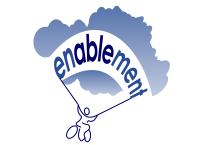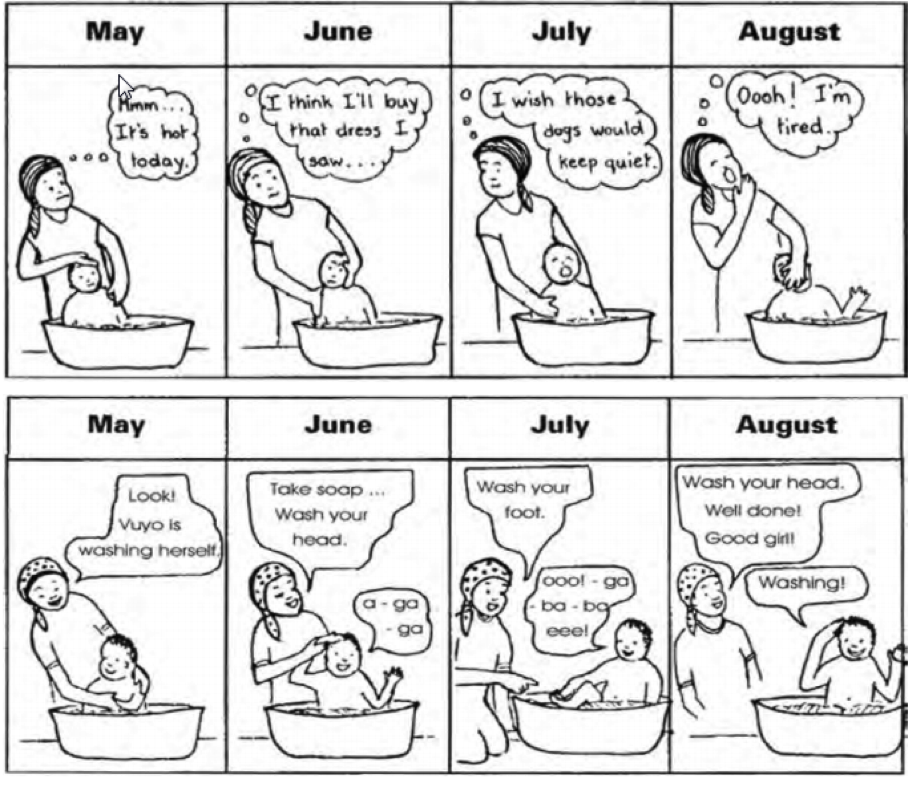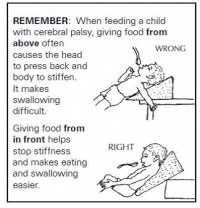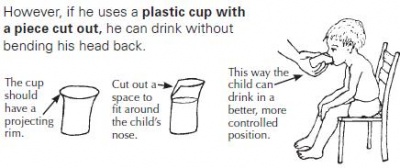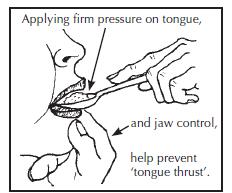Activities of Daily Living in Cerebral Palsy
Top Contributors - Naomi O'Reilly, Michelle Lee, Kim Jackson, Rucha Gadgil, Simisola Ajeyalemi, Olajumoke Ogunleye, Admin, Laura Ritchie, WikiSysop, Amanda Ager, Jess Bell, 127.0.0.1, Tony Lowe and Evan Thomas
Introduction [edit | edit source]
The information on this page has developed for you from the expert work of Roelie Wolting alongside the Enablement Cerebral Palsy Project and Handicap International Group.
Activities of Daily Living (ADL) Definition[edit | edit source]
The Activities of Daily Living refer to a series of basic or routine activities performed by individuals on a daily basis in order to take care of ourselves, and assist with independent living at home or in the community. There is not a fixed list of ADL's, as they depend on the age of the person, their intersts, the culture they live in, etc. When we talk about children, we usually refer to the basic activities of daily living which include feeding, eating, dressing, toileting, hygiene (bathing, oral hygiene, etc.) and moving around the house. There are many variations on the definition of ADL's but most organizations agree there are five basic categories.
- Personal Hygiene such bathing, grooming and oral care
- Dressing including the ability to make appropriate clothing decisions
- Eating, the ability to feed oneself although not necessarily prepare food
- Maintaining Continence or the ability to use a restroom
- Transferring oneself from seated to standing and get in and out of bed
Instrumental Activities of Daily Living (IADLs) Definition
[edit | edit source]
From a certain age, we should also start to examine what we call “Instrumental Activities of Daily Living”, needed for a greater degree of independence, such as moving around in the community, handling money. IADLs, often referred to as life skills, are actions that are important to being able to live independently but are not necessarily required activities on a daily basis. The instrumental activities are more subtle and can help more finely determine the level of assistance required by individuals. IADLs include:
- Basic Communication such as using a telephone
- Transportation, either by driving, arranging rides or the ability to use public transportation
- Meal Preparation and the ability to safely use kitchen equipment
- Shopping and the ability to make appropriate food and clothing purchase decisions
- Housework such as doing laundry and cleaning dishes
- Managing Medications such as taking accurate dosages at appropriate times and managing re-fills
- Managing Personal Finances, operating within a budget, writing checks and paying bills
ADLs are defined as "the things we normally do"...such as feeding ourselves, bathing, dressing, grooming, work, homemaking, and leisure.
Instrumental activities of daily living (IADLs) are not necessary for fundamental functioning, but they assist an individual to live more independently in a community. The rest of this page will focus on the ADL's of children with CP.
Activities of Daily Living and Cerebral Palsy[edit | edit source]
When children are born, they depend on their caregivers for most of their ADL's, except for being able to suck from the nipple or bottle. Gradually but slowly, children become more independent. At a certain age, most children begin having the motivation to do things by themselves and enjoy the feeling of achievement. A big part of a caregiver’s role is to help the child to gain independence.
Being able to perform ADL's effectively and independently demand skills in multiple areas:
- Gross Motor: e.g. in order to stay sitting or squatting while using the toilet, lift up a leg to put on trousers.
- Fine Motor: e.g. in order to undo a zipper, hold a spoon and bringing it to the mouth without spilling food.
- Visual
- Cognitive
- Sensorial
- Communication Skills, etc.
Children with Cerebral Palsy who are affected in any of these areas may have difficulty in performing some or all ADL's e.g. impaired hand function, which affects 50% of children living with Cerebral Palsy, will have an impact on child’s performance.
Knowledge of a child's Manual Ability Classification System (MACS) and Gross Motor Function Classification System (GMFCS) Levels can be useful when discussing expectations of, and goals for, the development of functional skills. We can predict that children classified as MACS I or II or GMFCS I or II will attain some independence in ADL's, although probably at a later age than typically developing children [1].
Some children will be able to become more or less independent with appropriate training and possibly modifications of the environment or the activity, while others with severe impairments will always need consistent care. Even for children who will always need help, parents can be trained and supported to allow children to participate where they can in ADL's. ADL's are very important moments in the daily life of a child and caregivers should be trained and encouraged to use these moments to:
- Help the Child Participate to the Best of their Ability / Potential: e.g. if the child can only use one arm, they should do as much as possible with that arm, even if the caregiver needs to finish the work afterwards. The caregivers shouldn’t rush to do it for the child only because it’s quicker.
- Try to Develop New Skills:Starting from the point where the child currently is, we can continue to work on new skills.
- Engage in Communication / Cognitive / Play Activities with the Child:e.g. Today we are going to put on a sweater because it is chilly outside. Do you like it when it is chilly? Which color is this sweater? And my sweater, which color is it? Now show me your right arm so I can help you to put the sweater on.
- Give the Child Options:Do you prefer this sweater or this other one? Even if a child needs a lot of physical help, developing a sense of autonomy, being able to take decisions and make choices, feeling that they has some control over their life, is crucial for well-being and psychological growth.
- Create Bond between the Child and the Caregiver: use ADL's to spend time looking at the child’s eyes, smiling, showing love and affection towards the child.
- Activities of Daily Living = Therapy / Development Time: Caregivers should be shown how to utilise the time engaging in ADL's to incorporate development skills and activities that the child needs to work on. This way it will be more likely that the caregivers will remember and will find the time to do them.
Using Daily Routine[edit | edit source]
Often parents do not have time to do all kind of extra activities with their child. The most effective way to work with the parents is to help them choose activities of daily life on which to focus and to choose those activities that are at that time the most important for them.
Some activities come back every day or even a few times a day. To focus on doing these activities in a proper way (good positioning) and in an active way (so the child is learning) will give many opportunities for the child to learn.
ADL Skill[edit | edit source]
ADL (sometimes also called Self Care Skills) play a major role in a child's overall functional growth, confidence and independence. These essential skills include the child's ability to feed themselves using utensils appropriately and to perform toileting, bathing and grooming activities. Problems in this area may be due to an underlying problem. This may include impaired Sensory Integration or diminished Fine Motor / Upper Body Coordination. Children may also exhibit poor motor planning which affects their ability to sequence, time and grade motor activities.
Eating and drinking[edit | edit source]
Eating and drinking: everyday it is done a few times. For most children with cerebral palsy is does not give challenges but for a few children with cerebral palsy it can be a difficult time. It can be difficult because of the way they are being fed or because they do not like it and have difficulty eating. For the parents it can be a difficult time, as it is can be very dificult and can take a long time to feed a child one proper meal.
Eating and drinking adequatley is important to prevent abnormal development of eating and drinking habits, which can become worse if we do not do anything it is also an important preparation for learning to speak.
Development of feeding skills according to age[edit | edit source]
Milestones for feeding development:
- Newborn: locates nipples as soon as it touches lips and sucks well.
- 6-7 months: begins to chew soft solid food and begins to drink from cup
- 1 year: begins to hold and use spoon and holds cup; can bit of pieces from biscuits; tongue moves from side to side when chewing
- 2 years: drinks from cup; eats and chews very well
- 3 years: eats independently
Difficulties eating and drinking experienced in cerebral palsy[edit | edit source]
Depending on the age of the child difficulties can include::
- Sucking the mothers breast
- Eating from a spoon
- Chewing and/or swallowing
- Closing mouth and lips
- Drinking from a cup
- Drooling
- Holding objects and taking them to the mouth
- Biting
- Hand mouth coordination
Activities to help with eating and drinking[edit | edit source]
Here are some things to consider to aid with the eating and drinking process:
- The body and the head of the child should be in the right position.
- When feeding the child: maybe sit in front of him or on the side of the child which relaxes him/her most.
- If you put pieces of food (e.g. biscuit) in the mouth of the child: put it at the side of her mouth and not on the tongue. Change side after each piece.
- When feeding with a spoon: push the spoon downwards on the middle of the tongue and wait till the child closes the mouth and takes the food form the spoon. If the child needs help with this: put a little pressure upwards under the chin (jaw control). Take the spoon out in a straight line.
- If the child cannot close the mouth when drinking help the child
- Use a straw, which can be easier for the child
- Cut out a piece of the cup (because of the nose), so the child does not need to tilt the head backwards.
Eating and drinking as a learning activity[edit | edit source]
The process of eating and drinking is a learning activity. Here are some of the ways the child can learn during this activity:
Preparing for eating/drinking:
Understanding and learning words (mother is telling what she is preparing, name of food, utensils, colours, asking where the plate or spoon is), talking (asking the child to tell what the mother is doing, the name of the food, tell where to find plate). Sitting, pointing, picking up the plate etc.
Eating and drinking:
- Sitting (head and trunk control, balance); opening mouth, chewing, muscle control and muscle strength of mouth muscles, eye hand coordination, taste of different kind of food; names of food and names of tast etc.
Cleaning up:
- Telling what needs to be done, helping with cleaning up (either by physical helping or by telling what needs to be done); sequence and planning of activities, balance.
Eating with others:
- Waiting for turn, listening to others.
Assistive devices for eating and drinking[edit | edit source]
Assistive devices can help the child to learn to eat by himself or to make it easier for him to eat and drink. When there are problems with eating and drinking parents often do not think about teaching the child to learn to do it by himself. Therapist often do not see the child during ADL and sometimes forget to use these times as practice time.
Personal Activities of Daily Living[edit | edit source]
It is important to teach the child personal activites of daily living such as washing, dressing, brushing hair etc. Here are some of the reasons why this is an important skill to work on:
- Child becomes independent
- Independence increases self-esteem and self-confidence
- Independence helps to prepare for school and life in the community
- Mother/family member gets relief
- The child learns words and their meaning: name of clothes, but also body parts and activities and words like in-out, under-above, colours, numbers.
- The child learns to pay attention, organise a task and figure out how to do it
- The child gets the opportunity to copy and imitate actions and words, to make choices and to indicate what s/he likes and dislikes.
- The child practices new physical skills by helping with and doing the ADL activities (fine motor, gross motor, balance)
- ADL helps to provide stimulation of all senses: vision, hearing, touch, smell, taste, movement.
- These activities are the best opportunity for the child to learn, because this has to be done every day and all members of the family can be involved.
- Some children will become self-reliant very fast, for others it will take a few years and others will never become independent but can make it easier for parents by helping. If it takes a long time to learn: make very small steps forward in order to seethe progress the child is making! (Gain Attainment Scale)
Communication is essential when learning new skills!
Additional Resources [edit | edit source]
- Chapter 36, Feeding from Disabled Village Children
- Chapter 37, Dressing from Disabled Village Children
- Chapter 38, Toilet Training from Disabled Village Children
- Chapter 39, Bathing from Disabled Village Children
- ↑ ÖHRVALL A, ELIASSON AC, LÖWING K, Ödman P, KRUMLINDE‐SUNDHOLM LE. Self‐care and mobility skills in children with cerebral palsy, related to their manual ability and gross motor function classifications. Developmental Medicine & Child Neurology. 2010 Nov 1;52(11):1048-55.


